|
On the last Wednesday of every month, I serve up a potpourri of advice, inspiration and other tidbits I've come across in recent weeks. In honor of the recent solar eclipse, this month's selection is all about light, dark and mystery. I will love the light for it shows me the way, yet I will endure the darkness because it shows me the stars. -- Og Mandino It is the dim haze of mystery that adds enchantment to pursuit. -- Count Antoine de Rivarol Where there is much light the shade is deepest. -- Johann Wolfgang von Goethe As we acquire more knowledge, things do not become more comprehensible, but more mysterious. -- Albert Schweitzer In the light we read the inventions of others in the darkness we invent our own stories. -- Alberto Manguel Mystery creates wonder and wonder is the basis of man's desire to understand. -- Neil Armstrong To me, every hour of the light and dark is a miracle,
Every inch of space is a miracle, Every square yard of the surface of the earth is spread with the same, -- Walt Whitman, Poem of Perfect Miracles, Leaves of Grass
2 Comments
With its towering forests, refreshing rivers and glittering lakes, the part of Michigan where we live might be the last place you'd expect to find patches of prairie. But find them you will, if you know where to look.  Setting out on our walk Setting out on our walk One fine swath, only a 15-minute drive from our house, is the Michigan Nature Association's Newaygo Prairie Nature Sanctuary. I visited the site last Saturday with a group from the River City Wild Ones native plant organization. Led by Michigan Nature Association regional stewardship organizer John Bagley, we poked around the prairie for a couple of hours, admiring such late-summer bloomers as rough blazing star (Liatris aspera), gray goldenrod (Solidago nemoralis), fern-leaf false foxglove (Aureolaria pedicularia), prairie sunflower (Helianthus petiolaris) and cylindrical blazing star (Liatris cylindracea). High overhead, nighthawks circled. Lovely to watch, but we also had to keep an eye on the ground to look out for prickly pear cactus (yes, cactus in Michigan!) and northern dewberry, also known as untie-your-shoe berry, for its habit of tangling around walkers' feet. John told us that the Michigan Nature Association purchased the 110-acre sanctuary in 1969. Prairies are considered endangered habitats in Michigan because so much open acreage was converted to farmland in the 19th and 20th centuries. But Newaygo County's hilly topography and sandy soils thwarted agriculture in some areas. Prescribed burns and removal of invasive plants, such as the noxious spotted knapweed, have helped keep the sanctuary in something close to its original state. "There's no place else in Michigan where you can find this quality of prairie," John said. "What makes it different is the diversity of plants—not only grasses but also forbs." (Forbs are herbaceous flowering plants that are not grasses.) Like all MNA sanctuaries, Newaygo Prairie depends heavily on volunteer help. John is "exceptionally good at involving local people in local sanctuaries," said Patricia Pennell, a founding member of River City Wild Ones and steward of another MNA sanctuary. Conservation and community: a winning combination, if you ask me.  Lichens and associated plants found on the prairie walk Lichens and associated plants found on the prairie walk A few more words about MNA before we venture any farther on our prairie ramble. Founded sixty-five years ago, the nonprofit organization was originally a bird-study group. But as environmental issues became a pressing concern throughout the state, MNA segued into education, converting a house trailer into a nature museum and towing it around to schools.  Newaygo Prairie is one of more than 170 Michigan Nature Association sanctuaries Newaygo Prairie is one of more than 170 Michigan Nature Association sanctuaries Before long, members realized they needed to do more, and the group began purchasing sensitive property to set aside as sanctuaries. Today, the organization maintains more than 170 sanctuaries throughout the state.  Fern-leaf false foxglove Fern-leaf false foxglove Newaygo Prairie—one of MNA's oldest sanctuaries—harbors more than a hundred plant species, as well as birds, insects and other animals that depend on those plants for food and shelter. On our walk, I saw several kinds of plants I'd not seen elsewhere, and I picked up some fascinating info-bits to stash in my natural history memory bank. For example:
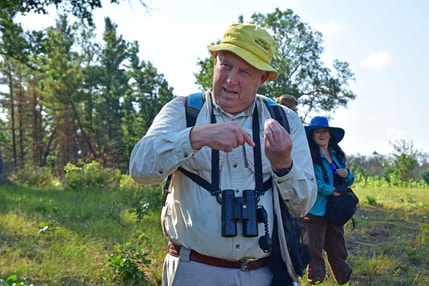 Ranger Steve Ranger Steve One highlight of the morning's walk was meeting "Ranger Steve" Mueller. Steve's business card describes him as "Naturalist – Photographer – Butterfly Chaser," and while that probably doesn't cover it all, it's a fair sum-up for a guy who spearheads annual butterfly counts, writes a nature column for local newspapers, operates his own nature sanctuary, and seems to know a heck of a lot about all manner of flora and fauna. I hope to visit Steve's sanctuary near Cedar Springs sometime soon. Stay tuned for that excursion. Is there a little-known nature preserve or wildlife sanctuary near you? What makes it special?
 The Artworks Second Monday Writers (minus me). Clockwise from top: Chris, Susan, Sally, Théa The Artworks Second Monday Writers (minus me). Clockwise from top: Chris, Susan, Sally, Théa Night before last, an eclectic group gathered in the basement of Artworks cultural center in Big Rapids. There was Chris, a dental hygienist; Théa, a former social worker; Sally, a retired educator; Susan, an artist who's, well, hard to sum up in a few words; and me. All brought together by our interest in writing—and in improving our writing. Let's listen in on snippets of the evening's discussion:  Chris comments on a submission Chris comments on a submission That one suggestion you gave me last time has added two-thousand words to my document! This did read much better for me, and now I have a clearer idea of the story. I'm more pulled in to what's happening. There is a difference between a run-on sentence and a long sentence that moves the story along. I've read 93-word sentences that are absolutely amazing. If you were to break one of those up, it wouldn't work.  Sally reacts to a comment Sally reacts to a comment I loved the images in your chapter. You create a lot of suspense. Ohhh, so I need to open the chapter with what the hell is going on! I think you're nailing the struggle I've had all along with the voice I want to use to tell the story. I didn't feel like I was reading this just for this group; I was reading because I enjoyed it. 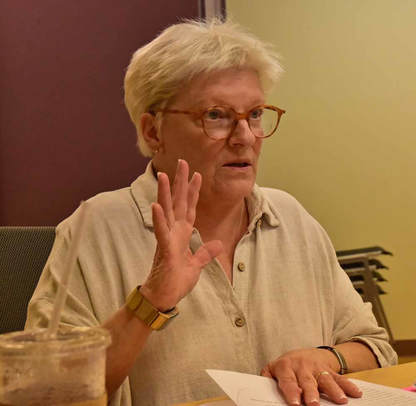 Susan makes a point Susan makes a point In one form or another, the Artworks Second Monday Writers have been carrying on like this for a dozen years. Founded by poet and writer Phillip Sterling, the group originally focused on fiction. Later, under the guidance of writer-photographer-biologist Stephen Ross, and then with writer and all-around lovely person Mikki Garrels at the helm, the group expanded to include writers of both fiction and nonfiction.  Théa enjoys a light moment Théa enjoys a light moment The group has waxed and waned over the years, with a full house of eleven members around the time I joined in 2012. Eleven writers, all submitting work for review and offering critiques of everyone else's work, eventually got out of hand. No matter how we tried to keep our comments concise, our meetings ran l-o-o-o-o-o-ong!  Tools of the trade Tools of the trade Now we're down to a manageable five members. Well, maybe manageable isn't quite the right word—we still get out of hand sometimes. But after working together over the years, we've learned a few things about how to give and take constructive criticism and avoid getting hung up on trivial matters.  Group dynamics Group dynamics Below, I'll share a few tips for writers' groups, in case you're thinking of starting one of your own (or already belong to one and need suggestions for making it work better). But before that, I want to introduce you to the Second Monday Writers and let them tell you about themselves and their projects.  Christopher Rizzo Christopher Rizzo Christopher Rizzo I’m currently working on a horror/supernatural story. It involves Dhampirs hunting old school demonic beings, set in a dystopian future. I've worked in many different genres, including Sci-Fi, fantasy, non-fiction and poetry. At the moment, I work as a dental hygienist in Lakeview Michigan.  Théa Heying (wearing some of her resale chic) Théa Heying (wearing some of her resale chic) Théa Heying I consider myself a skilled Hunter/Gatherer and resale shopping a blood sport. My work-in-progress, A Wilderness Guide to Resale Chic, is loaded with tips on how to sniff out treasure and navigate unpredictable resale terrain. Its message: You do not have to be born rich, win the lottery, or max out your credit cards to dress well and surround yourself with beautiful things. My background as a Licensed Master Social Worker and Cognitive Therapist informs my approach; having grown up in Michigan’s Upper Peninsula gives me an edge. My adult years in Chicago supply field experience: true tales and insider information. In addition to being a member of the writers group, I contribute to several Michigan newspapers and have been published in Michigan History magazine and Health and Safety magazine. I live on the Muskegon River near Big Rapids. Sally Kane  My current writing project is a memoir about visiting Cuba in 1980, during a brief period when the U.S. government allowed some educational travel to that country. The story weaves personal discovery and the effects of growing up white-middle class in the United States during the Cold War and the1960’s, with a de-mystifying of Cuba’s realities at that time. I also write poetry, essays and non-fiction stories. A retired early childhood educator and social worker, I also did Trager Bodywork and taught Movement Therapies for many years. In the mid-1980s, I lived and worked in Mexico and Central America with my husband, where I learned to speak and read some Spanish. In December 2016, I returned to Cuba, a trip that serendipitously coincided with the week of national mourning for Fidel Castro. In addition to writing, my interests are travel and learning about history and culture, reading, drawing and outdoor activities that correlate with the seasons, all balanced with political activism. I delight in caring for and playing with my granddaughter. Editor's note: Sally is also my neighbor and a member of the Monday morning yoga class and the Wander Women hiking group. Susan Stec  I write paranormal romance/humor, urban fantasy and horror for adults, new adults and young adults. My current project is a young adult urban fantasy that I'm co-authoring with Christopher Rizzo. I will write a seventeen-year-old shapeshifter wolf who does not accept her role in the wolf pack. Christopher is writing an angel with faery blood who was sent to earth to earn his wings by saving the shifter. Where I draw my characters from: I grew up in the streets of Bridgeport Connecticut, and that's where I got my education. By ten years old, I took care of my sister and brother and our four-room apartment while my mother worked two jobs. The city was a melting pot of good and evil, and by ten I knew it well, above and below ground, and was cold to its hardships. In my writing world, I weave reality with mythological creatures, fantasy, folklore, legend, and a fair share of humor, because without humor there is no sanity. What makes me smile: Walking in the woods, rainy days, and listing to the coyote at night. My art—watercolor, acrylics, book-cover and marketing graphics, stained glass. Listening to classic rock and writing. You can find me and my books here: Amazon http://amzn.to/1NjkU6B Facebook https://www.facebook.com/Susan-Stec-113043665460273/ Twitter https://mobile.twitter.com/suesan0814  Marked-up manuscript Marked-up manuscript Pretty interesting mix of people and projects, wouldn't you say? Before I joined this group, I had never read paranormal fiction, fantasy (at least not since childhood fairy tales) or much Sci-Fi. It's been enlightening—and fun—to be exposed to these genres, which are so different from the kind of writing I've done. I've been inspired to try my hand at fiction (not quite as far-out as some I've read in this group, but definitely a stretch from journalism and memoir!). In turn, the fiction writers in the group have offered insights on ways to enliven my writing. Things don't always run smoothly—what ever does when you get a roomful of distinct personalities? But we keep learning from one another, and our writing keeps growing as a result. Now, as promised, a few tips for writers groups:
Thanks to Mikki Garrels for filling me in on the early years of the Artworks Second Monday Writers.
This week, I'm taking time out to look back at some of this season's sweetest moments. It's been a beautiful summer so far, and outings and festivals have added to the enjoyment. But even when I've stayed on my own back porch or sat for a spell in the front yard, I've found plenty to appreciate. I hope you'll enjoy these sights as much as I have.
In winter, our outings are mostly mission-driven: venturing out to the store to stock up on groceries, returning books to the library, braving the elements to go to yoga practice or to a monthly writers' group meeting. Summer, on the other hand, is a time for aimless wandering.  Pentwater Pentwater Lately, we've been taking drives through the countryside with no particular destination in mind—sometimes only for an hour or two, other times for a whole day. A couple of Sundays ago, we headed out with the vague intention of ending up somewhere around Pentwater, a lovely little village northwest of here, bordered on one side by Pentwater Lake and on another by Lake Michigan. But we had all day, and we really cared more about along-the-way than about getting-there.  Cherry Point Market -- a refreshing stop on a summer day Cherry Point Market -- a refreshing stop on a summer day After driving through forests and rolling farmland, we came to Cherry Point Farm and Market and couldn't resist stopping. I'd heard about the farm—one of the oldest operating farms in Oceana County—and its lavender labyrinth. We could see from the road that the lavender was in bloom.  Earth mounds, planted with lavender, define the labyrinth's spiral path Earth mounds, planted with lavender, define the labyrinth's spiral path We parked and headed straight for the field where the labyrinth winds around and around a raised, circular herb garden. Labyrinths date back to ancient times and have long been used in garden designs. Unlike a maze, which offers bewildering choices of path and direction, a labyrinth typically has a single route to the center. 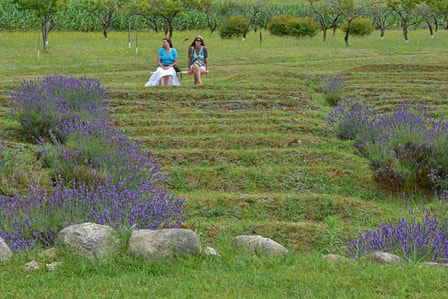 A quiet moment at the labyrinth A quiet moment at the labyrinth Many people use labyrinths for meditative walking; the spiral pattern suggests a spiritual journey or one's path in life. Lavender, with its calming scent and medicinal properties, seems a perfect fit for the design. We didn't walk the labyrinth—my recovering foot was still in the boot, and I was avoiding uneven ground—but we did wander through the Stone Circle Herb Garden. The garden is designed in accordance with principles of sacred geometry, with a pattern of overlapping circles defining 36 herb beds. Bee balm, calendula and a full palette of other flowers were blooming, and the air was perfumed with minty-grassy-earthy scents.
The farm also hosts special events during summer--Tuesday Tea, with sweets and lavender tea, and fish boils on Wednesday, Friday and Saturday evenings. And on Sunday mornings, Flapjacks and Fruit breakfasts. Just writing this paragraphs makes me want to go back and sample the fare at one of those gatherings.  Fresh cherries at the farm's market Fresh cherries at the farm's market Lunch left us satisfied, but not quite ready to leave. We strolled toward the market—where fresh cherries, cherry pie, cherry turnovers, cherry strudel, cherry jams and jellies and other goodies and gifts are sold—but we got sidetracked at the Word Garden. Scattered about the sunken rock garden are smooth stones painted with words. Visitors can arrange the word-rocks into evocative or humorous combinations. I guess it's not surprising that the farm has a Word Garden. Cherry Point owner Barbara E. Bull spends winter months writing books—one children's book, two historical tributes to her family farm, and three novels so far. Just one more manifestation of Cherry Point's imaginative spirit.  Imagination elevates the ordinary Imagination elevates the ordinary I left there thinking about how a touch of imagination can elevate the ordinary and create something memorable. From the spiraling paths through lavender, to the serene design of the herb garden, to the lanterns on the Board Room tables, to the Word Garden, this wayside stop was a rich reward on a summer day. Where have you found imagination at play this summer? Cherry Point Farm and Market is at 9600 W. Buchanan Road, Shelby, Michigan, 1.5 miles south of Silver Lake on Scenic Drive (B15). Open daily from April through October. Current hours are 8am to 9pm (shorter after Labor Day).
|
Written from the heart,
from the heart of the woods Read the introduction to HeartWood here.
Available now!Author
Nan Sanders Pokerwinski, a former journalist, writes memoir and personal essays, makes collages and likes to play outside. She lives in West Michigan with her husband, Ray. Archives
April 2022
Categories
All
|












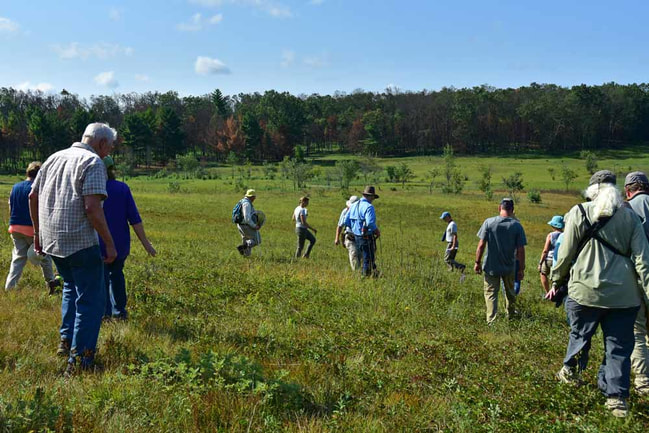


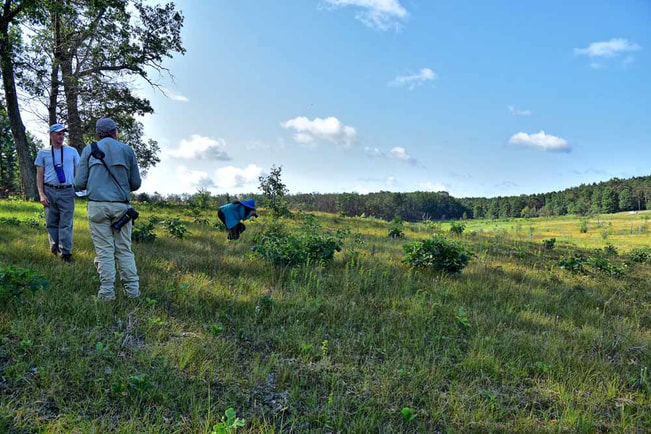

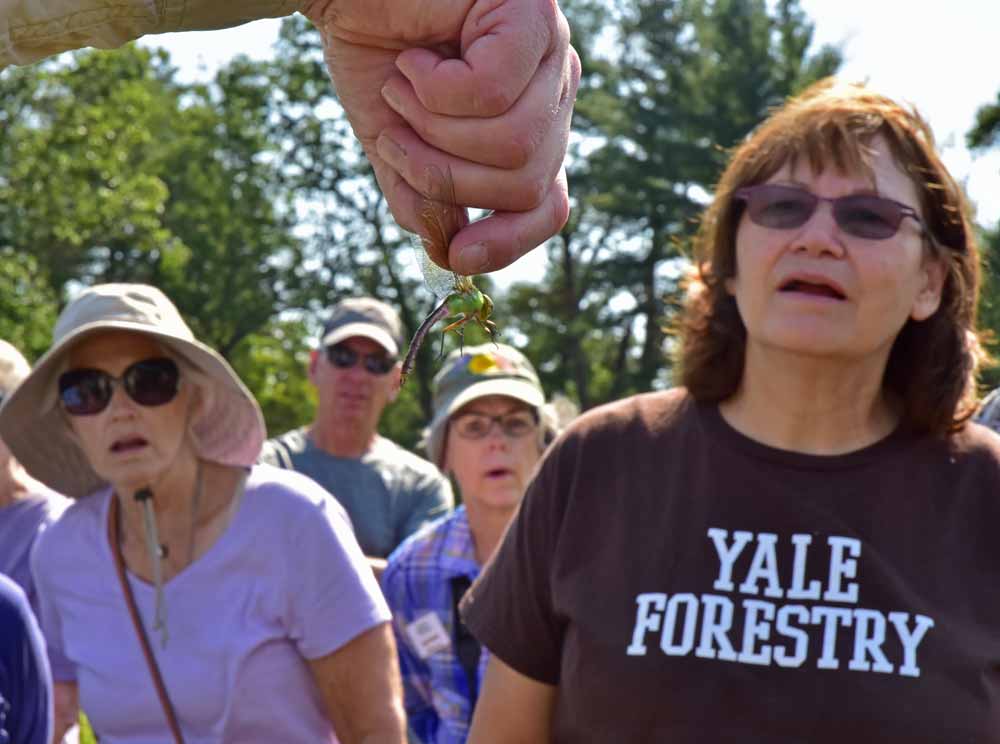



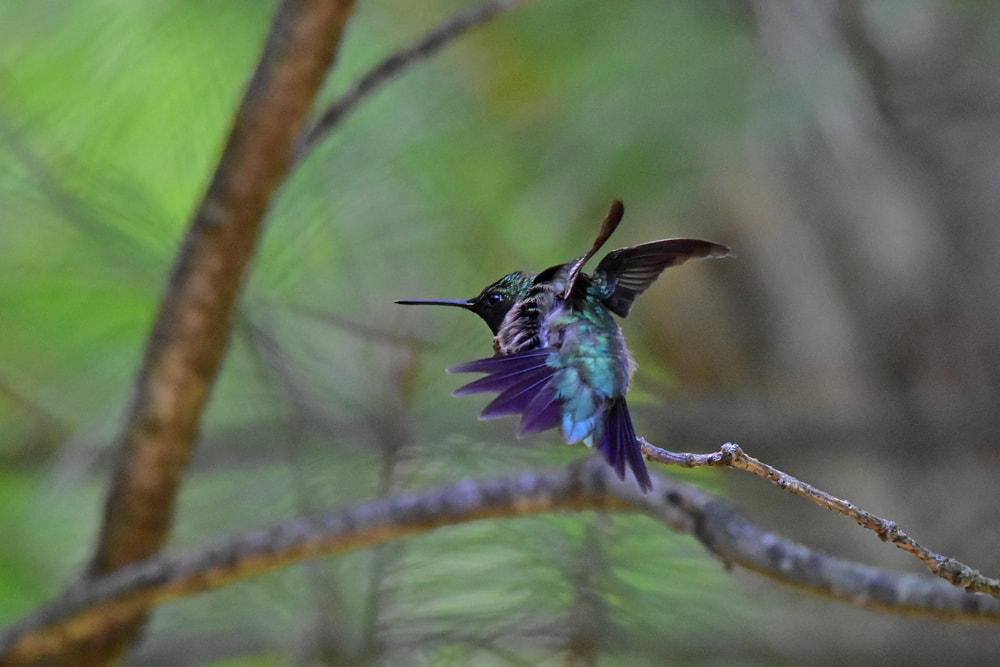






























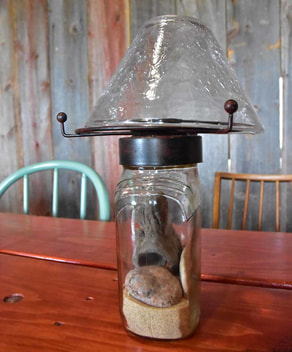


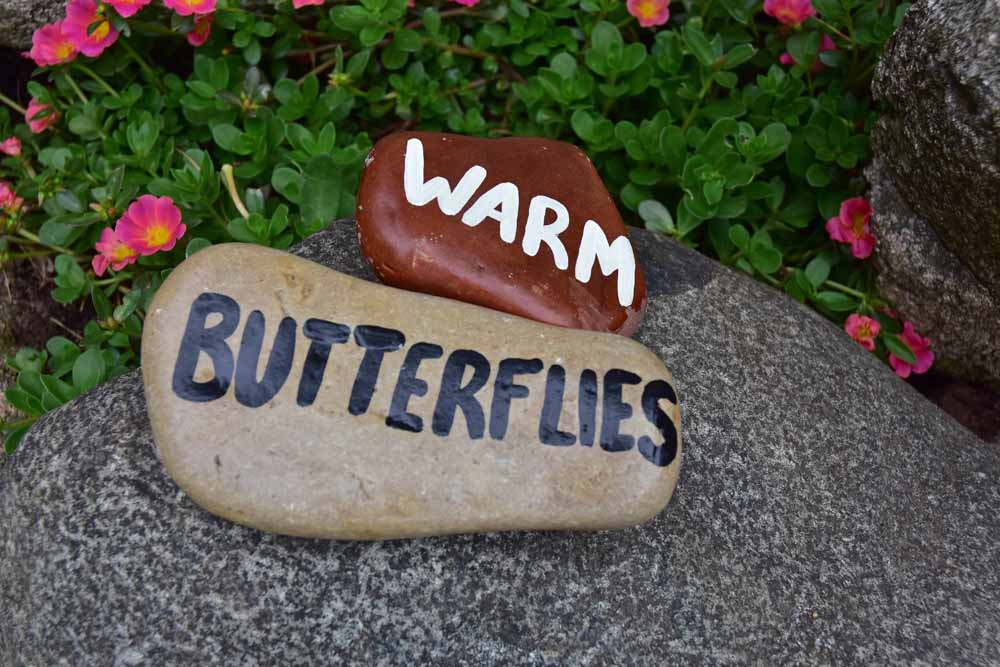





 RSS Feed
RSS Feed